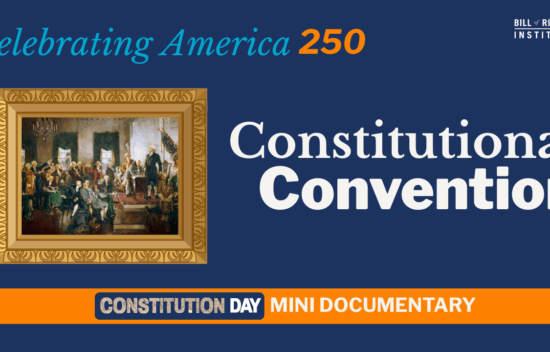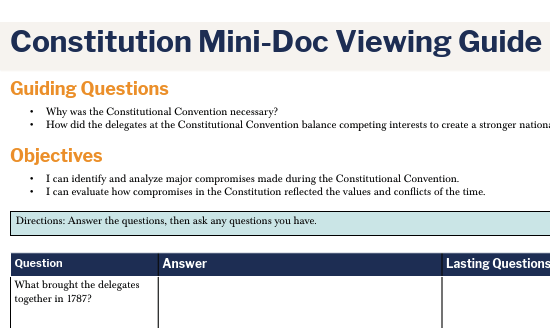
Constitutional Convention Mini-Documentary
Essential Questions
- How did the Constitutional Convention attempt to solve the problems of the new nation?
- In what ways did its compromises reflect both the ideals and the conflicts of the time?
Guiding Questions
- Why was the Constitutional Convention necessary?
- How did the delegates at the Constitutional Convention balance competing interests to create a stronger national government?
Objectives
- Students will…
- Identify and analyze major compromises made during the Constitutional Convention
- Evaluate how those compromises reflected the values and conflicts of the time.
Student Resources:
Teacher Resources:
Facilitation Note
Prep for the lesson by watching the mini-doc and preparing 2-3 “pause and talk” moments.
Engage
- Term(s) for pre-teaching or explicit instruction: compromise
- Ask students to imagine the following scenario individually: The U.S. government has just fallen apart. There’s no president, no courts, and states are fighting over money and borders. You’ve been called to a secret meeting to fix it. What are 3 rules you’d put in a new national government to hold the country together?
- After a few minutes, call on students to share what rules they came up with and what difficulties they faced in coming up with them.
- Focus on any rules that contradict one another and ask students how they might compromise on those rules.
- Transition: Tell students: This was what delegates faced in 1787, when 55 men met in Philadelphia to deal with a failing Articles of Confederation. Today, we will watch a mini-documentary on the Constitutional Convention and see how the new government was developed and what compromises made it happen.
Explore
Viewing the Video
- Before class begins, prepare 2-3 points in the video to “pause and talk.”
- Hand out the viewing guides and play the video, stopping at points to “pause and talk,” and as needed to give students time to fill in their viewing guide.
- Mini-Pair Shares During Viewing
- To add accountability and clear up confusion, students compare answers, ask questions, and add anything they missed or misunderstood.
Quote Analysis
- Transition: Tell students: Let’s analyze one of the quotes from the mini-doc.
- Display Benjamin Franklin’s words “I have often in the course of the session looked at that behind the President without being able to tell whether it was rising or setting. But now at length, I have the happiness to know that it is a rising and not a setting sun.”
- Give brief context. For example: Franklin is speaking on the last day of the Convention, referring to a carved sun on George Washington’s chair.
- Scaffolding note: A picture of the chair can be found here.
- Additional questions for discussion and reflection:
- What does Franklin mean by a “rising” sun? What would a “setting” sun have meant in 1787?
- Why do you think he used this metaphor instead of saying “the Constitution will succeed”?
Assess & Reflect
- Answer the follow-up questions on the viewing guide.
- Name two major compromises made during the Convention.
- How did each compromise balance competing interests?
- Which compromise do you think was the most effective? Why?
